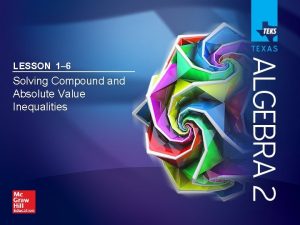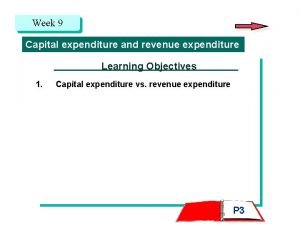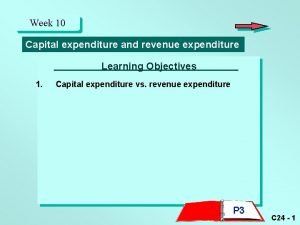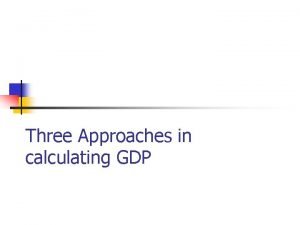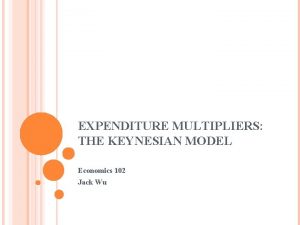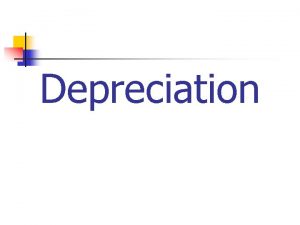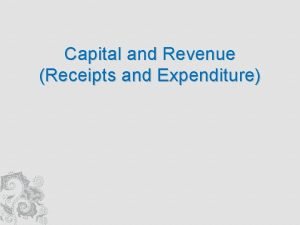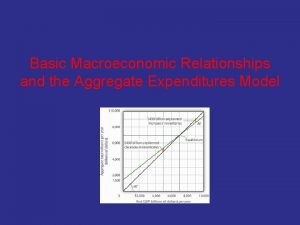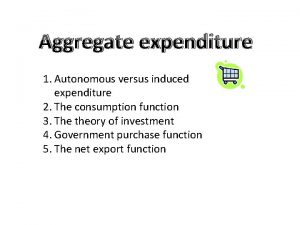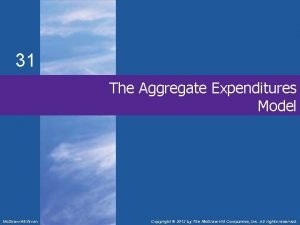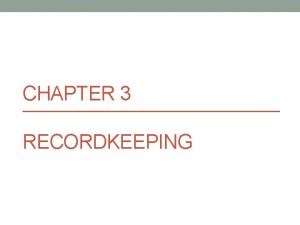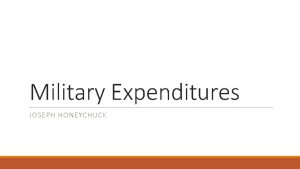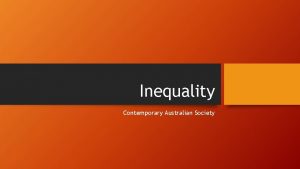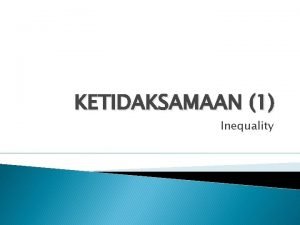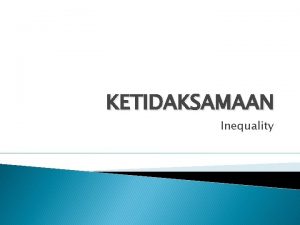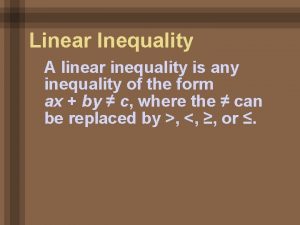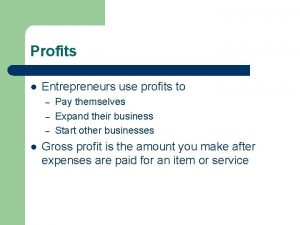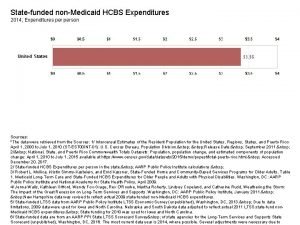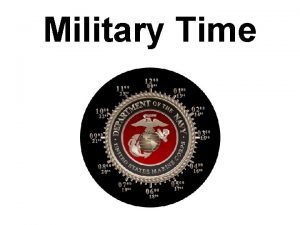Soft Modelling of Military Expenditures Inequality and Profits














- Slides: 14

Soft Modelling of Military Expenditures, Inequality and Profits Ali Cevat Taşıran Middle East Technical University, North Cyprus Campus Adem Yavuz Elveren Fitchburg State University, MA January 6, 2017 Chicago

160 2 SLS Ali (2012) 1987 -2005 MENA countries 2 SLS Kentor et al. (2012) 1970 -2000 82 GLS Lin & Ali (2009) 1987 -1999 58 Panel Granger Töngür & Elveren (2015) 1988 -2003 37 GMM Töngür et al. (2015) 1963 -2000 130 GMM Milex Al Tö i (20 ng 07 ür ; 2 & 01 AD Elv 2) Pa inc er ; Li en n les y is rea s (2 & A h s-s ig es 01 li kil he 5) (20 led r i be ; T 0 n ön 9) ; lab m nef gü Ke or ilita its r, an ry poo Hs ntor d s in r u& a kil du rela ta led str ti E l v ve l. (2 R& ies; ely re 01 D gu m n ( 2) pe ns or 20 rso -bu e 15 nn tte ) el r 1987 -1997 lia ra te ) in 10 20 s t e( Uy rce pu & ou out es ne f r and un n o nt : D ey tio e rv ca ym Su llo plo re isa m M er e gh Ali (2007) u at Method Inequality Growth Higher S higher I; large sunk costs; higher work effort Poor invest less in H; instability uncertinity & less investment Kuznets Dunne & Uye (2010) i) negative and ambiguous effects are more common ii) recent studies: negative effect iii) positive effect is more pronounced in the case of developed countries Hi # of Countries er Period Lit Study Töngür & Elveren (2016) growth=f(milex, inequality) Augmented Solow growth model, 82 countries, 1988 -2008

, ity tiv uc od pr ce or nan via y lab mi ity C b ing e do tiv OC as re rad 6) duc ng or inc t. t 01 ro si ect d, in (2 p rea s an ut su ng c ive m bo H uci , in ns de g a n &red ods inte ing in re t, go al as ing Elvge ou ve” apit re br ti c din uc a Inc ow od ng Cr repr andi p n “u ex Al Tö i (20 ng 07 ür ; 2 & 01 AD Elv 2) Pa inc er ; Li en n les y is rea s (2 & A h s-s ig es 01 li kil he 5) (20 led r i be ; T 0 n ön 9) ; lab m nef gü Ke or ilita its r, an ry poo Hs ntor d s in r u& a kil du rela ta led str ti E l v ve l. (2 R& ies; ely re 01 D gu m n ( 2) pe ns or 20 rso -bu e 15 nn tte ) el r Milex Inequality Profit Might be (+) in SR but (-) in LR, Vasudevan (2015) Palley (2002), Dutt (2006), and Carvalho and Rezai (2016): high AD was maintained by “debt-fueled consumption” Edward N. Wolf (2015) inter alia Elveren & Hsu (2016) 24 OECD countries 1963 -2008 A panel autoregressive distributed lag model for the whole period in the post-1980 era weak evidence: for armsexporting countries, nonarms-exporter countries

Method • Why Partial Least Squares Path Modelling (PLS-PM)? • Different theories Different conceptualizations different measurements of the variables incorrect types of empirical distribution functions of the Threevariate • No consistent empirical distribution specifications of Military Expenditures, Inequalities and Profits. • Problem is complex, theoretical knowledge is scarce/complex, and no information about distributions of the dependent variables • So, PLS modelling is the most appropriate technique in this context, as it uses Least-Squares oriented but distribution-free methods.

Data • The analysis covers 21 countries for the years from 1988 to 2008 • Argentina, Australia, Brazil, Canada, Chile, China, France, Germany, India, Indonesia, Italy, Japan, Korea, Mexico, Netherlands, Russia, Spain, Sweden, Turkey, UK, US • 423 observations and 125 variables

Data Set Source World Income Distribution http: //www. gc. cuny. edu/Page-Elements/Academics-Research-Centers. Initiatives/Centers-and-Institutes/Luxembourg-Income-Study. Center/Branko-Milanovic, -Senior-Scholar/Datasets COW http: //www. correlatesofwar. org/data-sets Nordhaus et al. (2012) William Nordhaus, John R. Oneal and Bruce Russett (2012). The Effects of the International Security Environment on National Military Expenditures: A Multicountry Study. International Organization, 66, pp 491513 doi: 10. 1017/ S 0020818312000173 size of informal economy http: //www. econ. boun. edu. tr/public_html/Re. PEc/pdf/201205. pdf size of informal economy http: //www. gfintegrity. org/storage/gfip/documents/reports/world_bank_ shadow_economies_all_over_the_world. pdf Marxian profit rate https: //sites. google. com/a/newschool. edu/duncan-foleyhomepage/home/EPWT UTIP-UNIDO manufacturing Theil pay http: //utip. lbj. utexas. edu/data. html inequality index UTIP-EHII inequality index http: //utip. lbj. utexas. edu/data. html SIPRI http: //www. sipri. org/research/armaments/milex_database World Development Indicators http: //data. worldbank. org/data-catalog/world-development-indicators US Department of State’s Bureau of http: //www. state. gov/t/avc/rls/rpt/wmeat/ Verification and Compliance Center for Systemic Peace, Major Episodes of http: //www. systemicpeace. org/inscrdata. html Political Violence, 1946 -2014 (War List) Uppsala Conflict Data Program www. prio. no/cscw Penn World Tables http: //www. rug. nl/research/ggdc/data/pwt-8. 1

Results-no heterogeneity

Results-with unobserved heterogeneity Response-Based Unit Segmentation (REBUS)

Results Korea Australia Netherlands Spain Sweden Turkey Canada France Italy

Results Netherland UK US Canada France Germany Japan

Results Mexico Turkey Brazil Chile Argentina

Results China India Indonesia

Results • 1) Milex has larger negative effect on profits when overall profit rates are higher. • 2) Milex has positive effect on profits when Milex is smaller. • 3) Higher Milex increases income inequality in countries with very large or very small military expenditures. • 4) When inequality is low, higher Milex leads to both lower income inequality and profits. • 5) When inequality is high, higher Milex leads to both higher income inequality and profits.

THANK YOU!
 Lesson 1-6 solving compound and absolute value inequalities
Lesson 1-6 solving compound and absolute value inequalities Capital expenditures
Capital expenditures Revenue expenditure vs capital expenditure
Revenue expenditure vs capital expenditure Gdp formular
Gdp formular Environmental expenditures
Environmental expenditures Tax multipler
Tax multipler Daily cash expenditures
Daily cash expenditures Consumption expenditures formula
Consumption expenditures formula Motor vehicle depreciation
Motor vehicle depreciation Tina talor
Tina talor Revenue expenditure examples
Revenue expenditure examples Aggregate expenditure model
Aggregate expenditure model Autonomous vs induced expenditure
Autonomous vs induced expenditure Aggregate expenditures model
Aggregate expenditures model Section 3-3 using a budget answers
Section 3-3 using a budget answers
